BLOG
Circling around Kyo-ryori
This is a guest post by KJ friend, Dominique Götz.
It’s a rainy day, quite unusual for June in Basel, though not in Kyoto, where the rainy season has just started. Lush cherry trees, heavy with little green and red fruits, surround the Buckminster Fuller Dome, looking a bit like a misplaced igloo on the green meadow of the Vitra Campus. From the street, the Dome looks empty, and visitors might have passed it by if they hadn’t known about the opening of the exhibition, “Kyoto Food Shaping”. Every year during Art Basel there is an exhibition held at this venue. This year the Vitra Design Museum, in collaboration with the Basel architects Shadi Rahbaran & Manuel Herz and KIT (the Kyoto Institute of Technology), exhibits the results of four years of research detailing how food shapes the urban spaces, culture and life of Kyoto. It is not surprising that this exhibition is held at the Vitra design campus in Weil am Rhein, Germany, just 15 minutes from Basel, the city of architecture and art. Under the bow-shaped ceiling visitors can walk around a circular table and learn about the history of Kyoto and its food production, distribution, and the role of soil and water, markets, urban housing and seasonal festivals. One of the most interesting points the research brought to light was the fact that Kyoto, as an inland city, was forced to develop special manufacturing technologies, such as drying and salting, for preparing sea products. Unlike Basel, which lies in the heart of Europe, bordering onto Germany and France, Kyoto was able to persevere and develop a unique food culture. Like Basel, Kyoto is surrounded by large agricultural areas and, in earlier times, was shaped by a river transporting regional produce. The research also showed how water, especially the quality and amount of ground water, plays an important role: lots of water is needed for the processing of tofu, and the availability of soft water is the basis of the distillation of sake.

The Buckminster Fuller Dome at Vitra Campus
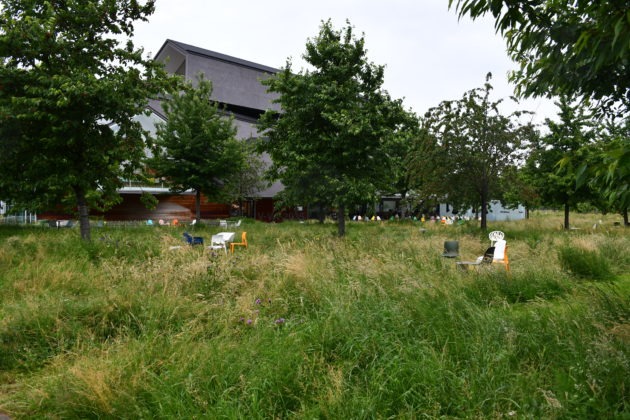
The cherry trees at Vitra Campus
Whoever thought that food could shape a city and its culture in such a distinguished way? The graphic design of the exhibition, with kanji and short texts, beautifully illustrates the different types of food influenced by the seasons, the imperial court, monks, samurai, and fisherfolk. The food displays, lacquerware, and pottery were lent by the Kyoto Food Culture Museum “Ajiwaikan” – it is hard to refrain from touching the shiny and silky textures of the kaiseki- or shojin-ryori dishes or the plump white daikon on the wooden table. In the heart of the dome one can turn a short round in the arcade library, as simply and stylishly designed as the rest of the exhibition. Even the video tent, showing different food places like the Tambaguchi wholesale market and the Nishiki Market downtown is circular. “Originally the exhibition was designed to correspond with the round design of the Dome,” explains Architect Manuel Herz, though “quite unintentionally it reflects the circle of food.” In contrast to the dark rain clouds, the Dome is illuminated white. Looking up the ceiling, one can admire the Japanese shoji paper, referencing the “yuba- sheets” hung to dry in the production areas of Nishiki Market.
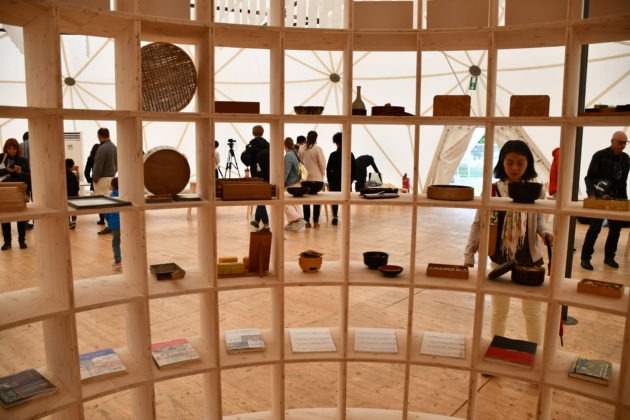
Inside the exhibition space
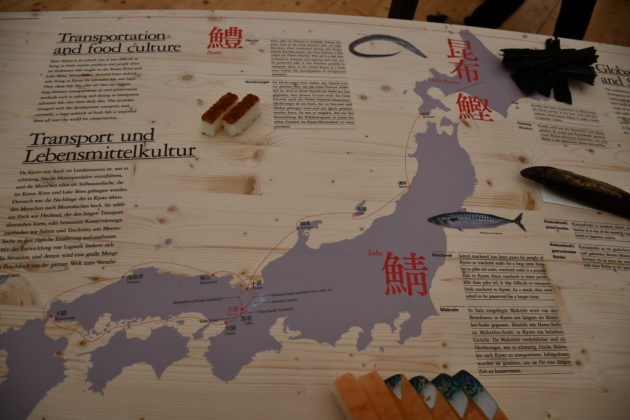
The main varieties of fish found in the coastal waters of Japan
Finally it is time for the “food performance.” At the food stalls, only a few steps away from the Dome, a long queue is already forming – not in a disciplined Japanese fashion, but more in a friendly loose mop. Swiss, Germans and Japanese expatriates are trying to get a glimpse of Kumiko Tanaka, head of a renowned Nishiki Market stall, scooping her egg mixture with a wooden ladle into the makiyakinabe and patientliy folding the dashimaki rolled omelette with her chopsticks. Whoever is lucky enough to collect a rectangular piece of her creations enjoys its fluffy texture on their tongue. The subtle taste of dried bonito and brown seaweed magically brings Kyoto to life: a well-balanced taste, complemented by Roku-Gin and Spanish tonic water. “Oh, it is very fine”, a young Swiss woman enthuses. “Oishii,” replies her friend. And “oishii”(delicious) is probably the most popular word among foreigners, quickly picked up by all fans of Japanese cuisine. The perfect word to round out this Kyo-ryori food experience.
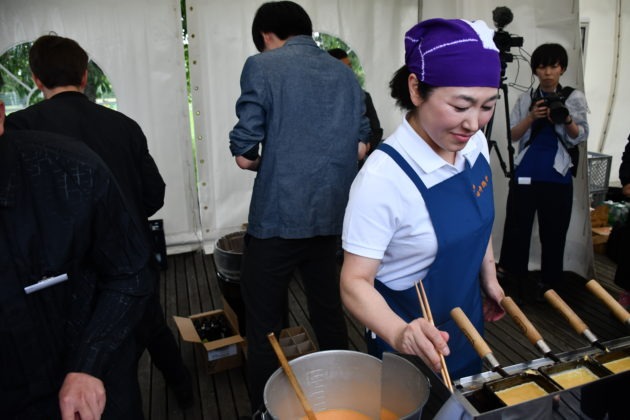
Watching Kumiko Tanaka at work.
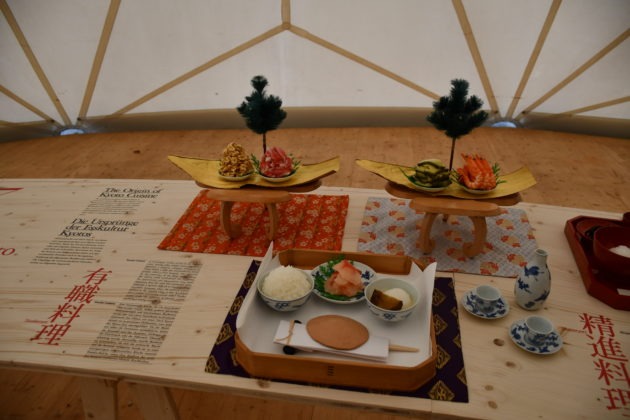
Yusoku Ryori (有職料理): The refined cuisine of the imperial court during the Heian Period
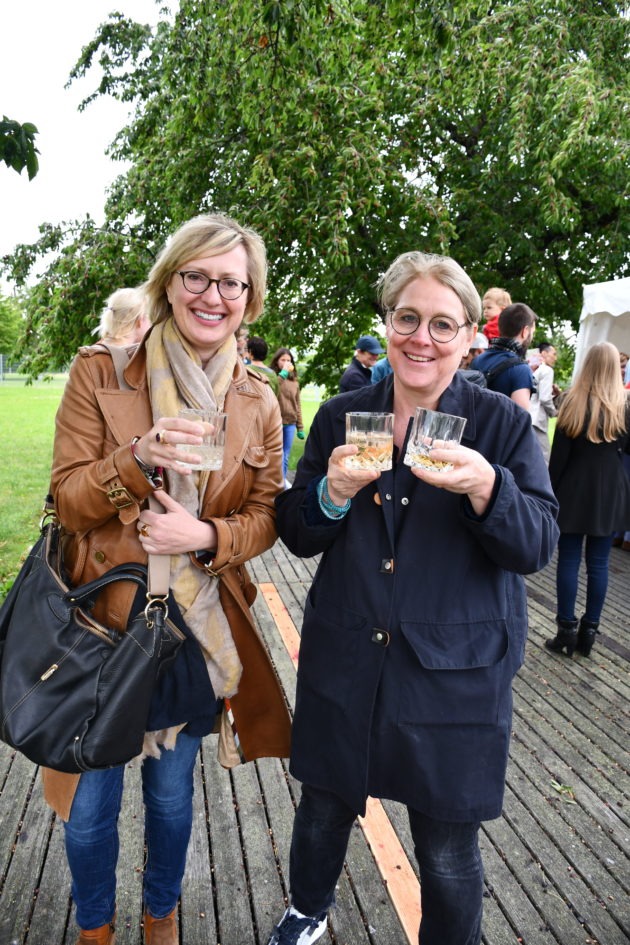
The author and her sister-in-law enjoying a G&T
The Kyoto Food Shaping Exhibition ended 17 June 2019.



